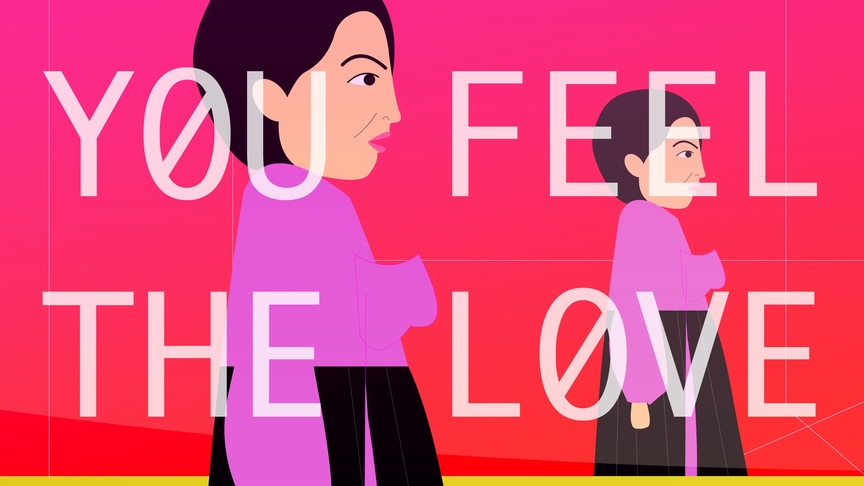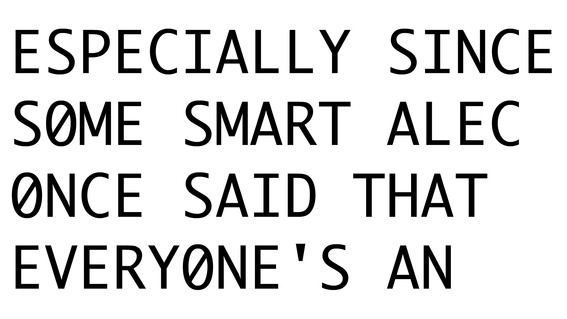
R
E
V N
E
X
T
Young Hae-Chang Heavy Industries: H0W L0NG IS F0REVER?
Still image from YOUNG-HAE CHANG HEAVY INDUSTRIES’ ART IS A LIE THAT JUST W0N’T DIE, 2014, HD QuickTime movie with original text, sound: 6 mins 29 secs. Courtesy Young-Hae Chang Heavy Industries.
*In 2018, ArtAsiaPacific hosted a Young Writers Contest to celebrate its 25th anniversary year. This essay by Kaitlin Chan won second place. Read Najrin Islam’s entry (third place) here and Joyce Wong’s winning entry in Issue 111 of AAP.
On August 21, 2018, Hong Kong’s M+ Museum announced its acquisition of the complete body of work by Seoul-based internet art duo Young Hae-Chang Heavy Industries (YHCHI). This unprecedented accession is the first time a major international museum has ever bought a still-expanding oeuvre by living artists. The decision raises questions on what it means for an institution to own future works by artists, as well as how YHCHI’s practice as internet artists relates to broader of concerns of time and contemporaneity in new-media art forms. Both the software YHCHI utilize create their animations and the internet landscape in which their work circulates have undergone significant changes over their career to date. Their deliberately anachronistic work questions whether, given the hyper-accelerated rate of technological development, any internet artwork can ever be truly contemporary.
When YHCHI began experimenting with Adobe Flash in the late 1990s, the graphics software represented the cutting edge in animation and was installed widely on computers to enable the display of audiovisual content. In July 2017, when Adobe announced their discontinuation of Flash from 2020 onwards, YHCHI’s first priority was to consider alternative ways of producing work in their signature style, perhaps through developing an app or learning a new programming language. Employing the latest technology to create artworks that deliberately evoke the early 2000s is arguably part of the duo’s critique. The directness of their scathing social commentary is so closely linked to their minimal, now-retro visual style that they have rarely strayed from it.
While the duo continue to produce Flash animated videos of text set in Monaco font, their work has morphed from broad takedowns of consumerism or fear of the North Korean government to address the recent casualties of the internet age, namely the personification of corporations through social media, as well as the harvesting of personal data by the world’s most lucrative companies. A L0VE SUPREME (2017), for instance, made in collaboration with new-media artist Takuji Kogo, articulates YHCHI’s critique of how digital devices enable the penetration of capitalism into our personal lives and visual space. In this work, YHCHI abandon their usual monochrome background for a saturated orange and pink gradient, in which an animation of a lone woman in a fuchsia hanbok walks continuously rightward, her lips moving as if she is mouthing the lyrics to the video’s soundtrack. The text, which appears overlaid onto the video’s protagonist, fuses banal ad copy (“WANT BETTER SEX / JUST CASH A CHECK”) with vague aspirational calls to action (“IMPR0VE Y0UR LIFE”). The bombardment of messages directed at a single figure speaks to how today’s netizens are constantly seduced into buying the life they have always wanted, with just one click.
Since 2008, when ArtAsiaPacific published curator and then-Rhizome director Lauren Cornell’s feature article on YHCHI, “Flash-Flood,” in Issue 58 (May/June 2008), South Korea has become the country with the highest percentage of smartphone owners and internet users. The text in A L0VE SUPREME, such as “X-RATED GIRLS” and “A BL0W0UT SALE” precisely mirrors the ads for sex or for products found all over the internet. However, YHCHI also cite the consequences of this consumption, most notably “EXPL0DING PH0NE,” an overt reference to the scandal over Samsung’s handsets catching fire in 2017. The video ends abruptly, freezing the hanbok-clothed woman mid-sentence, mid-step, as if to suggest that the cycles of digital consumerism could and will repeat ad infinitum.
YHCHI’s videos expose the mechanisms
of not only all-powerful technology companies, but also elite art institutions. For example, ART IS A LIE THAT JUST W0N’T DIE (2014) pokes fun at the disproportionate amount of power museums wield in the construction of the art-historical canon. The video opens with the declaration that “99% 0F ALL ART
IS BAD,” before going on to describe
how museums validate select artists: “MUSEUMS INF0RM US WITH STATEMENTS LIKE ‘THIS W0RK IS GENIUS, BLAH, BLAH, BLAH.’” The
ironic humor employed in this piece is undeniably complicated by the fact that all of YHCHI’s work is now in the collection of a major institution.
M+’s accession of YHCHI’s past, present and future oeuvre can be interpreted as the duo’s challenge to contemporaneity. YHCHI, recognizing the technical impossibility of creating internet art “of the moment,” have sold their future works to a museum that positions itself not as a steward of art objects per se, but a collection including “twenty-first-century visual culture.” By guaranteeing that all of their work will be carefully preserved for future netizens to access, they bypass the aggressive pace with which internet-connected devices and software are updated, rendered obsolete, and replaced. The internet is a graveyard of dead links to broken or mangled content, and YHCHI’s museum accession ensures that full-time staff will tend to their Flash videos long after Flash is discontinued.
Perhaps YHCHI has always meant to operate from an ambiguous place of conspiracy, as their group name would suggest. They can criticize Samsung’s corporate greed in various artworks, while also utilizing product sponsorship in their creations—as they did with their GATES 0F HELL installation of nine Zipel Samsung refrigerators at Rodin Gallery, Seoul, in 2004. They mock the self-importance of the institution while also striking historic accession deals. In the post-Flash years, as the duo continue to make works that are guaranteed, by contract, to end up in the collection of M+, it is unpredictable where, and what, they will strike next.
To read more of ArtAsiaPacific’s articles, visit our Digital Library.















